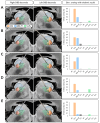Optimal stimulation of the thalamic centromedian nucleus in children with Lennox-Gastaut syndrome: patient series
- PMID: 40982986
- PMCID: PMC12455224
- DOI: 10.3171/CASE25478
Optimal stimulation of the thalamic centromedian nucleus in children with Lennox-Gastaut syndrome: patient series
Abstract
Background: Lennox-Gastaut syndrome (LGS) is a severe developmental and epileptic encephalopathy characterized by multiple seizure types, intellectual disability, and distinctive EEG findings. Deep brain stimulation of the centromedian nucleus (CM-DBS) is an emerging therapy for LGS, but pediatric experience remains limited.
Observations: The authors report a single-center experience with CM-DBS in 6 children and adolescents (ages 12-18 years) with LGS. One patient experienced infection-related device removal after 2 months. The remaining 5 received sustained stimulation for 2.5-5 years. All 5 showed caregiver-reported improvements in seizure burden and alertness, with corroborating Clinical Global Impression-Improvement scores. Three patients exhibited marked seizure reduction following targeted reprogramming toward a previously identified optimal target of stimulation in the anterolateral CM. Pre- and post-DBS scalp EEG recordings were available in 1 patient and showed a reduced burden of interictal discharges.
Lessons: CM-DBS is a promising treatment for pediatric, medically refractory LGS when resective approaches are unsuitable. Benefits were sustained over years. Lead localization and direction of stimulation appear important to optimize clinical benefit. These findings support the feasibility and safety of pediatric CM-DBS and highlight the need for prospective trials incorporating EEG-based outcomes and patient-centered measures including comorbidities and quality of life. Early, network-targeted neuromodulation may improve long-term outcomes. https://thejns.org/doi/10.3171/CASE25478.
Keywords: Lennox-Gastaut syndrome; deep brain stimulation; drug-resistant epilepsy; functional neurosurgery; generalized epilepsy; neuromodulation.
Figures



References
-
- Camfield PR.. Definition and natural history of Lennox-Gastaut syndrome. Epilepsia. 2011;52(suppl 5):3-9. - PubMed
-
- Arzimanoglou A, French J, Blume WT.Lennox-Gastaut syndrome: a consensus approach on diagnosis, assessment, management, and trial methodology. Lancet Neurol. 2009;8(1):82-93. - PubMed
-
- Specchio N, Wirrell EC, Scheffer IE.International League Against Epilepsy classification and definition of epilepsy syndromes with onset in childhood: position paper by the ILAE Task Force on Nosology and Definitions. Epilepsia. 2022;63(6):1398-1442. - PubMed
LinkOut - more resources
Full Text Sources

